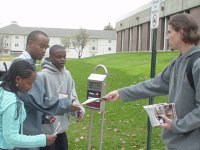
Leafleting is a great strategy for outreach and education. One person can hand out hundreds of leaflets in a short amount of time, it doesn’t require a lot of planning, it can be mobile, and having friendly outgoing people in the streets for animals is great for our image. Leafleting isn’t a quick fix for helping animals, but it does sow seeds for people to reduce their consumption of animal products or even go completely vegan.
- Dress appropriately. It’s most effective to identify with your audience, and our appearance is an important first impression. This is especially true for us because we’re talking to people about ideas that are kind of “out there” for the majority of people. Because our group focuses on campus outreach, the guidelines for what is considered mainstream are loose. However, what would be considered the norm on campus might not fly if you’re leafleting on Nicollet Mall in downtown Minneapolis during lunch hour. We want people to focus on animals and factory farming, not distract or turn them off by how we look.
- Smile and be friendly to the people you interact with. If you look friendly, people are more likely to take the information and ask questions.
- Generally city sidewalks and property belonging to public colleges and universities are legal areas to leaflet on. Do not impede pedestrian traffic. If you leaflet on private property, you may be asked to leave. If you are, do so immediately. Failure to do so is tresspassing.
- Concerts, colleges and universities, high schools, churches, festivals, and other places with sizable crowds are good places to leaflet. It’s best to get there before the crowds (i.e. before a concert lets out, there is a passing time at a college, or a parade starts) and be prepared to make the most of the time you have by having extra literature ready.
- Leafleting in the city can be successful depending on the hour and location. Standing in the middle of Downtown or in Uptown for an hour during a lunch break or on the weekend can reach hundreds of pedestrians and shoppers.
- Good pieces of literature that provide a background on animal issues while promoting plant-based diets are Vegan Outreach’s pamphlets. Contact Vegan Outreach about getting pamphlets.
- Always be polite and outgoing, even if you are treated rudely. If we respond in a hostile manner, we are not doing the animals any good. It is important to set a good example and always be friendly and respectful when handing out literature. If someone isn’t interested, you can say “Enjoy your day”, or something to that effect and let them go.
- When approaching people, what you say may depend on the literature you’re distributing. Good general things to say are “Info on helping animals?”, “Info on animal cruelty?”, “Info on factory farming?” and anything else along those lines. Make sure people see the cover of the pamphlet, as that will oftentimes speak for itself. See what works well for you and go with it.
- You may get asked questions regarding plant-based diets and animal issues. Refer to and familiarize yourself with CAA’s Guide to Frequently Asked Questions to competently address any questions that may arise. If you don’t know how to respond to something, you can refer that individual to sources that will help her or him find out, like the Internet or our books, videos, or other media.
- Do not talk at length with people who are rude or uninterested in listening to what you have to say. It is better to simply ignore those that want nothing more than to pick a fight and rile you up. Don’t get discouraged and waste your time; just move on to other people who are more receptive.
- It is common for someone to take a leaflet if the person before them took one. It is also common for someone to refuse if the person before them refused. If you aren’t successful at first, wait a moment and smile as you offer information to someone who hasn’t seen anyone dismiss you.
- Passing out leaflets to teenagers and young adults is generally more effective than leafleting adults, as youth are often more open-minded and willing to make changes in their lifestyle. If there are many people around you while leafleting and you have to pick one, it is usually more productive to just leaflet a younger person over an adult.
- It is helpful to take a leaflet from your stack and extend it out to them, rather than just showing them what you have and waiting for them to come take it. Most people will take what is handed to them, but won’t come to take something from you.
- Look around for abandoned leaflets before leaving. Not only does this benefit the environment, but it also saves us resources by reusing discarded leaflets and recycling leaflets that are in bad condition.
- Another good way to distribute leaflets is to drop them off at nearby coops, restaurants, cafes, veterinarian clinics, record shops, and any other place where flyers are permitted. Leave just a small stack of literature at each place, in case they get thrown out. (It may be best to check with the owner ahead of time so this doesn’t happen.)
Also see:
- Mercy for Animals offers excellent tips on how to leaflet
- Vegan Outreach’s Suggestions for Leafleting
